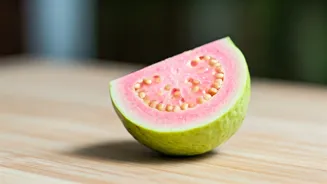Introduction to Japanese Produce
Japanese cuisine is celebrated globally not only for its flavors but also for its emphasis on fresh, seasonal ingredients. Vegetables form a cornerstone
of Japanese diets, providing vital nutrients and contributing to the longevity and well-being associated with this culinary tradition. The use of vegetables in Japanese cooking often goes beyond mere sustenance; it's an art form, where each ingredient is valued for its inherent qualities. The climate of Japan supports the growth of a wide variety of vegetables, each offering a unique flavor profile and nutritional benefit. From root vegetables to leafy greens, Japanese cuisine skillfully incorporates these ingredients to create a balanced and healthful diet, promoting overall vitality. Understanding the nutritional value of these vegetables is a step towards appreciating the holistic approach to health that defines Japanese culinary traditions.
Daikon: The Giant Radish
Daikon, a large, white radish, is a staple in Japanese cuisine. Its mild, slightly peppery flavor makes it incredibly versatile, and it can be eaten raw, pickled, or cooked. Daikon is a low-calorie vegetable, rich in vitamin C, which is essential for immune function and overall health. Furthermore, daikon contains enzymes that aid digestion, promoting a healthy gut. The texture of daikon varies depending on how it's prepared, ranging from crisp when raw to tender when cooked. It's often used in soups, stews, and as a garnish. Its adaptability allows it to complement a wide range of flavors, making it a key component in both traditional and modern Japanese dishes. It can be found in a variety of dishes, including oden, a winter stew, and as a side dish to grilled fish.
Edamame: Power-Packed Beans
Edamame, or young soybeans, is a popular snack and ingredient in Japanese cuisine. These bright green beans are a nutritional powerhouse, providing a significant amount of protein, fiber, and vitamins. Edamame is a complete protein, meaning it contains all nine essential amino acids that the body needs but cannot produce on its own. It's also a good source of iron, which helps in carrying oxygen throughout the body. The high fiber content in edamame supports digestive health and can help regulate blood sugar levels. Commonly enjoyed steamed with a sprinkle of salt, edamame is a satisfying and healthy snack. They can also be added to salads, stir-fries, and soups. Its versatility and nutritional density make it an ideal choice for maintaining a balanced diet.
Spinach: Leafy Green Goodness
Japanese spinach, or 'horenso', is a leafy green that’s celebrated for its nutritional richness. This vegetable is an excellent source of vitamins A, C, and K, as well as several minerals like iron and folate. Spinach is known for its antioxidant properties, helping to protect cells from damage. It is also good for eye health because it contains lutein and zeaxanthin. Japanese spinach is often used in salads, side dishes, and soups, adding both flavor and nutritional value to any meal. This green can be easily incorporated into many dishes, and it's a versatile ingredient in various recipes, contributing to a balanced diet. Its nutrients support bone health and boost immune function, making it an essential part of any healthy eating plan.
Shiitake Mushrooms: Umami Boosters
Shiitake mushrooms are a popular ingredient in Japanese cuisine, valued for their savory 'umami' flavor and impressive health benefits. These mushrooms are a good source of several nutrients, including B vitamins, which are crucial for energy production. They also contain compounds that may help boost the immune system and reduce inflammation. Shiitake mushrooms are often used in soups, stir-fries, and as a key ingredient in many traditional dishes. Their meaty texture and rich flavor make them a versatile ingredient. Shiitake mushrooms are also known for their potential to lower cholesterol levels and support overall cardiovascular health. They are a delicious and nutritious addition to any meal.
Sweet Potato: Energy Packed
Japanese sweet potatoes, often known as 'satsumaimo,' are a delicious and nutritious staple in Japanese cuisine. Rich in complex carbohydrates, they provide sustained energy. They are loaded with vitamins, including vitamin A, which supports vision, and fiber, essential for digestive health. Sweet potatoes also contain antioxidants that protect the body from damage by free radicals. They are often roasted, steamed, or fried. The naturally sweet taste makes them a favorite in both savory and sweet dishes. Their vibrant color and flavor make them a popular choice. The high fiber content helps manage blood sugar levels and promotes satiety. Sweet potatoes are a versatile and nutritious addition to any diet.
Napa Cabbage: Versatile and Healthy
Napa cabbage, also called Chinese cabbage, is a versatile vegetable that is widely used in Japanese cooking. It has a slightly sweet flavor and a tender texture, which is ideal for both raw and cooked preparations. Napa cabbage is a good source of vitamins C and K, as well as fiber. It contributes to overall health with its high water content and low-calorie count. It can be found in many dishes, from salads to stews. It's a key ingredient in miso soup. The mild flavor makes it an adaptable addition to various meals. It is a great way to add nutrients to your daily diet, supporting overall wellness and digestive health. Napa cabbage offers a blend of flavor and nutrition, making it a valuable vegetable.
Burdock Root: Earthy and Nutritious
Burdock root, or 'gobō', is a long, brown root vegetable prized in Japanese cuisine for its earthy flavor and nutritional benefits. This root is high in fiber, which supports digestion and helps maintain a healthy gut. It also contains antioxidants that protect the body. Burdock root is often used in stir-fries, stews, and salads, providing a unique texture and flavor. Its crunchy texture and earthy taste make it a unique vegetable. It has been used for centuries for its medicinal properties. Rich in vitamins and minerals, burdock root contributes to overall health. It is frequently used in traditional dishes. It is a nutritious ingredient that brings a unique flavor to Japanese dishes.












